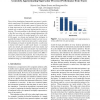Free Online Productivity Tools
i2Speak
i2Symbol
i2OCR
iTex2Img
iWeb2Print
iWeb2Shot
i2Type
iPdf2Split
iPdf2Merge
i2Bopomofo
i2Arabic
i2Style
i2Image
i2PDF
iLatex2Rtf
Sci2ools
ISPASS
2009
IEEE
2009
IEEE
Accurately approximating superscalar processor performance from traces
Trace-driven simulation of superscalar processors is particularly complicated. The dynamic nature of superscalar processors combined with the static nature of traces can lead to large inaccuracies in the results, especially when traces contain only a subset of executed instructions for trace reduction. The main problem in the filtered trace simulation is that the trace does not contain enough information with which one can predict the actual penalty of a cache miss. In this paper, we discuss and evaluate three strategies to quantify the impact of a long latency memory access in a superscalar processor when traces have only L1 cache misses. The strategies are based on models about how a cache miss is treated with respect to other cache misses: (1) isolated cache miss model, (2) independent cache miss model, and (3) pairwise dependent cache miss model. Our experimental results demonstrate that the pairwise dependent cache miss model produces reasonably accurate results (4.8% RMS error)...
| Added | 19 May 2010 |
| Updated | 19 May 2010 |
| Type | Conference |
| Year | 2009 |
| Where | ISPASS |
| Authors | Kiyeon Lee, Shayne Evans, Sangyeun Cho |
Comments (0)

